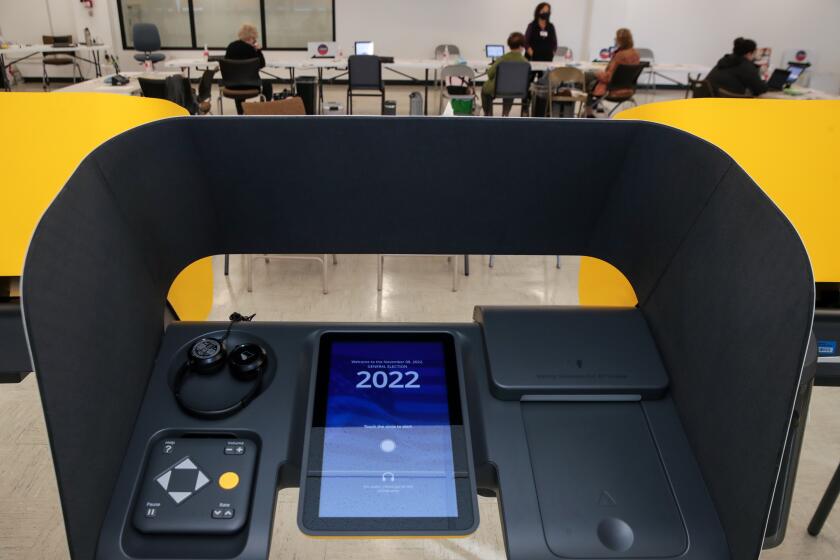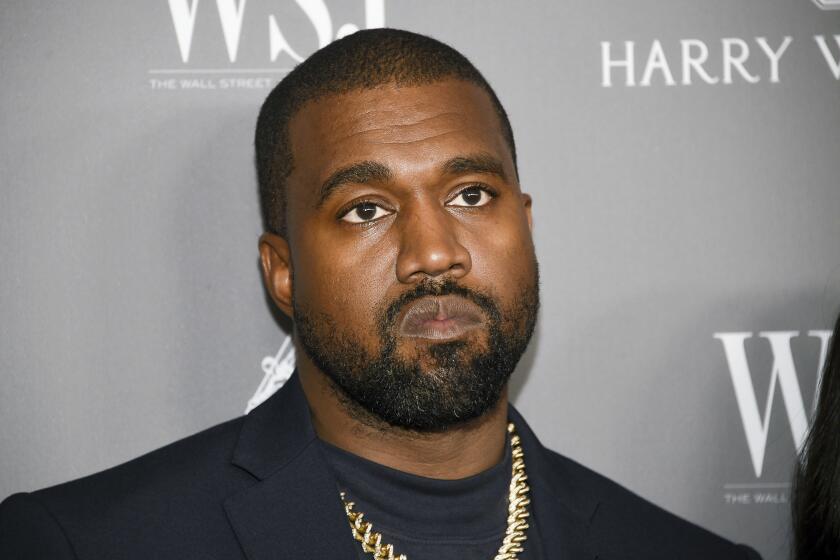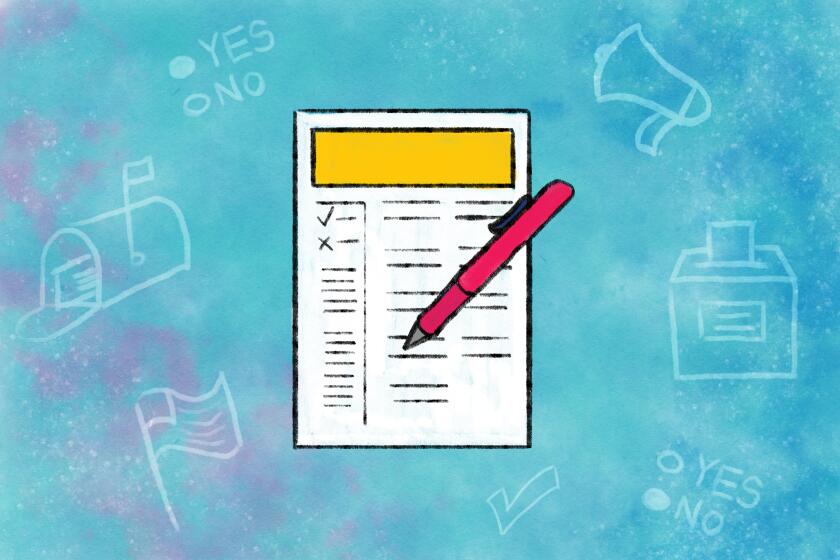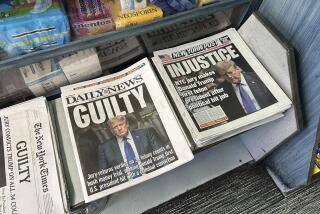‘Media literacy’ advocates push to create savvier consumers of news and information
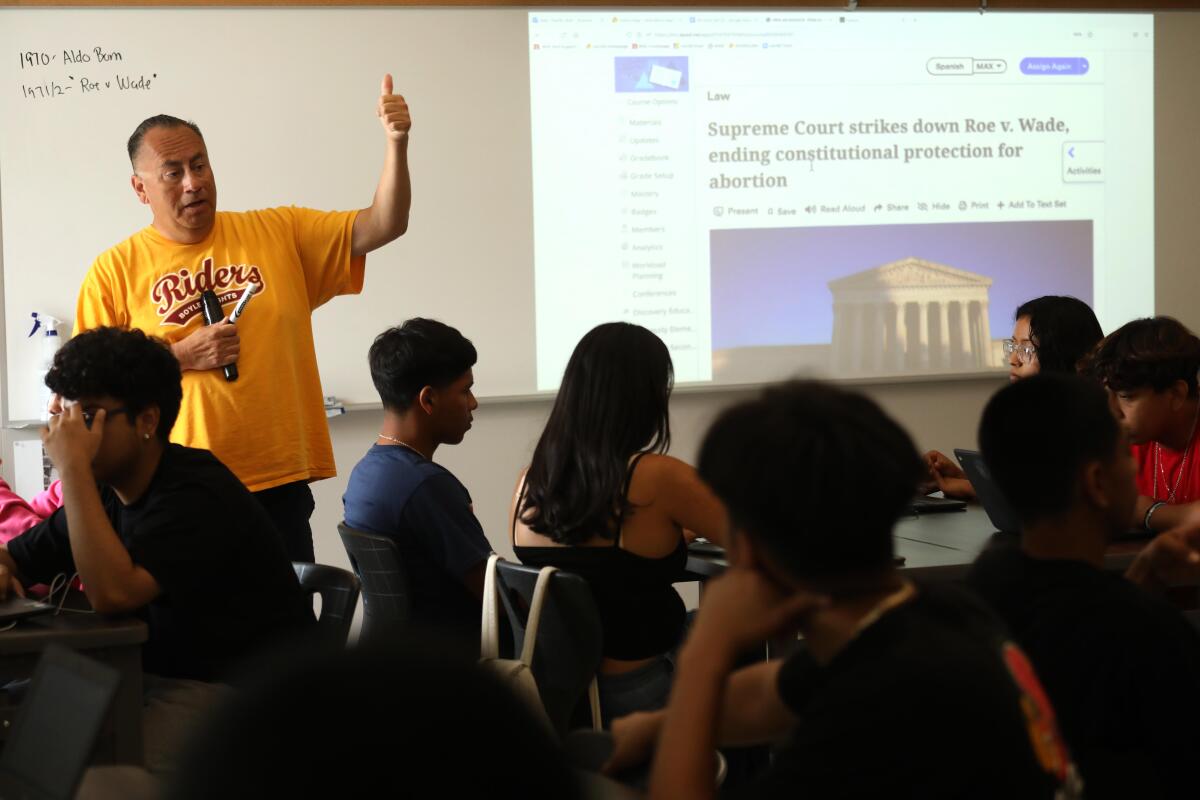
- Share via
The Instagram headline was pithy and alarming: “Head of Pfizer Research: Covid Vaccine is Female Sterilization.” And the report, from a murky source, could have had real-world consequences, coming in 2020, just as the U.S. rolled out the first vaccines to combat the pandemic.
That made the story a perfect tool for an educator trying to teach high school students how to separate fact from fiction — a survival skill in a culture drowning in a tsunami of information.
Jamie Gregory told the 12th-graders in her seventh-period journalism class to examine the article. But, using lessons from a nonprofit called the News Literacy Project, they understood that the best way to get to the truth was not to read deeply in the suspect story but to check it by shifting away to other sources.
The teenagers soon found stories and academic studies debunking the sterilization claim. A Reuters story made clear that the former Pfizer scientist had drifted far from the scientific mainstream on COVID-19. Research never corroborated rumors that the vaccine caused impotence in men or placenta failure in women.
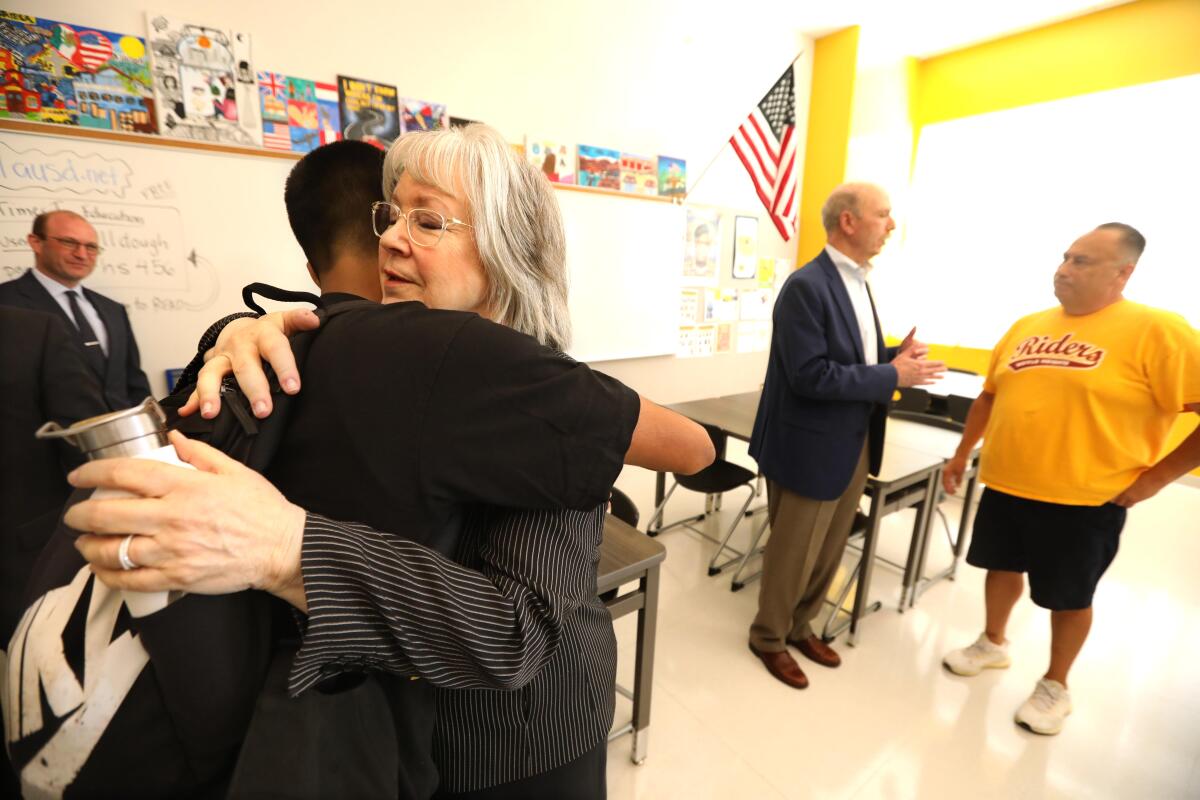
“They really had to do the work to figure it out for themselves,” said Gregory, a librarian and journalism teacher at Christ Church Episcopal School in Greenville, S.C. “It felt important that they had developed this skill. And it does make me feel hopeful going forward.”
Gregory is one of a growing number of teachers, librarians, counselors and other educators who are teaching media literacy: skills like discerning advertising from unpaid content, recognizing the difference between news and commentary and separating unbiased sources from those with ties to industry or political groups.
The cascade of false stories since the attack last week on Paul Pelosi, husband of House Speaker Nancy Pelosi (D-San Francisco), illustrates how quickly and aggressively misinformation campaigns can spread after major news events.
“Media literacy is literacy in the 21st century,” said Erin McNeill, founder and president of the nearly decade-old advocacy group Media Literacy Now. “There is this fire hose of information coming at young people, and they have to know how to cope with it.”
Fifteen states now encourage some form of media literacy education, compared with three in 2011, according to Media Literacy Now. Illinois last year became the first state to mandate such instruction, requiring all high schoolers to take a unit (still to be defined) on issues like “the purpose of media messages and how they are constructed.”
What do you need to know about the 2022 election? Find out with these voting guides for local and California races and state propositions.
California lawmakers and Gov. Gavin Newsom in 2018 directed the Department of Education to create an online list of media literacy resources. In September, state officials approved adding media literacy to the list of subjects eligible for funds for teacher training and instructional materials.
But while the media literacy movement is growing, so is debate about exactly what the term means.
By its broadest definition, the concept suggests that people who consume media (American 10- to 14-year-olds spend nearly eight hours a day consuming content on phones, computers and televisions) should be better informed about what they take in. That can mean learning about ad placement in movies, sussing out the political roots of television shows and learning who’s behind a TikTok video.
“There are overt and hidden messages throughout media,” said Michelle Ciulla Lipkin, executive director of the National Assn. for Media Literacy Education. “They are in sports, in entertainment, in sitcoms on TV, on film — not just the traditional news.”
In a class she teaches at Brooklyn College in New York, one focus is to get students to understand that what they see on their screens can have as much, or more, impact on their worldviews as NPR or some other traditional news source.
“I can’t not talk about ‘Black-ish’ in my class,” said Lipkin. “That is a very good example of a sitcom that is bringing deep and intense messaging about race into our living rooms.”
Kanye West was dropped by Adidas and his talent agency, after ‘brazen’ and ‘unapologetic’ antisemitic rhetoric.
Among the leading organizations in the field is the News Literacy Project, founded in 2008 by Alan Miller, a longtime Los Angeles Times reporter whose career included a Pulitzer Prize-winning investigation into the dangers of a military attack jet.
In the 14 years since it started, initially to help young people cope with the information onslaught, the organization has shifted its focus to a menu of online video lessons, delivered under the brand name “Checkology.”
Miller said his belief in the need for the teaching has grown in the last several years, as broad segments of the American populace have been consumed by election denialism, skepticism about global warming, COVID-19 conspiracy theories and what former President Trump’s aide Kellyanne Conway once notoriously defended as “alternative facts.”
“We’ve lost any sense of a common narrative, of a shared reality,” said Miller. “We not only can’t agree on what the facts are, we can’t even agree on what a fact is.”
That threatens any chance of a well-informed electorate, said Miller.
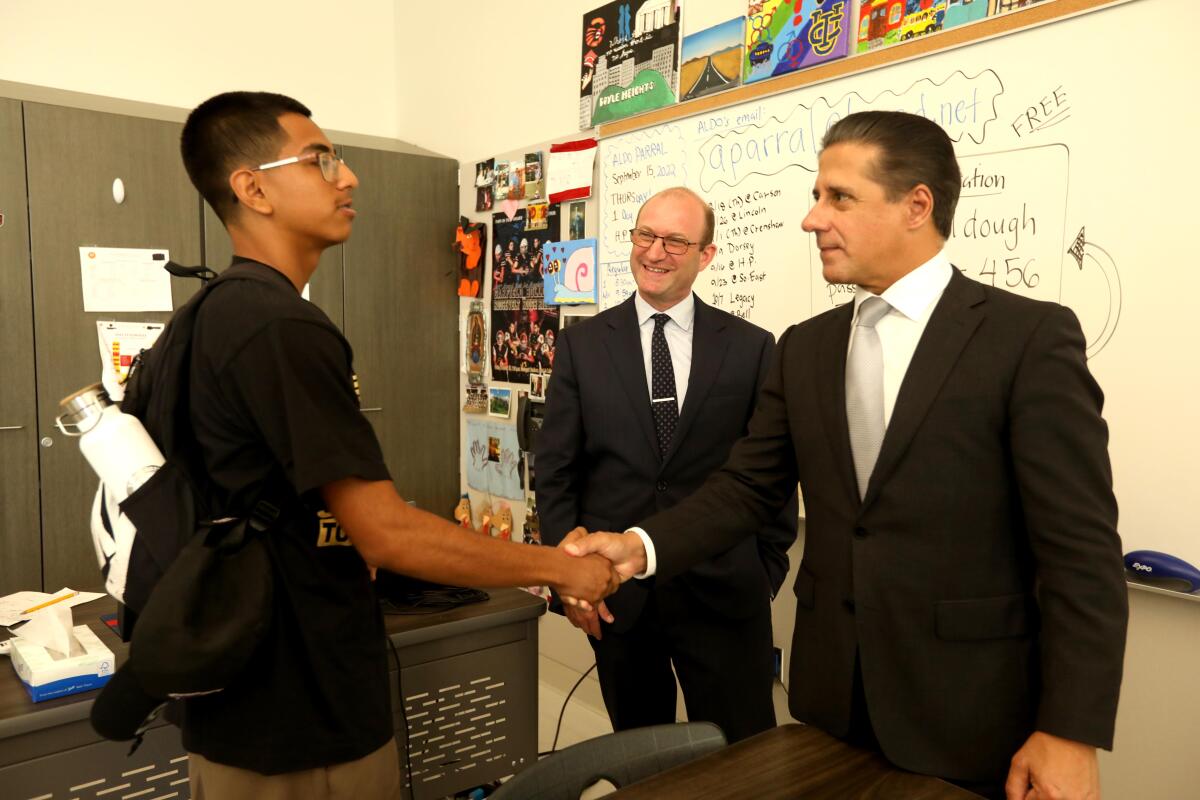
Studies have shown that well-meaning individuals across the political spectrum have trouble separating fact from fiction.
In what they billed as “the largest investigation of its kind,” Stanford researchers last year assessed how 3,446 high school students interacted with information on the internet. Two-thirds couldn’t distinguish news from ads on a popular website’s home page. Virtually all of the students were hoodwinked by a website that claimed to offer unbiased facts about climate science that were actually talking points from the fossil fuel industry.
Fortunately, the Stanford group had other research suggesting that the learning chasm can be bridged. Exposing high school students to the tools used by professional fact-checkers significantly improved their “ability to judge the credibility of digital content,” the researchers found.
One of the key skills, the study found, was what academics call “lateral reading” — jumping away from a suspect article and opening new web tabs to find out more about the credibility of whoever produced the report. Groups like the News Literacy Project are focused on bringing that and other online verification skills to middle school and high school students.
Among students’ favorite fact-checking tools: using Google and other sites to perform “reverse image” searches that can verify the source of provocative photos that pop up on Instagram and TikTok.
At Roosevelt High School in Boyle Heights, one of 20 L.A. Unified schools that have gotten additional resources through the Partnership for Los Angeles Schools’ network, teacher Aldo Parral recently walked his students through a News Literacy Project lesson on forms of bias, sometimes fueled by a journalist’s race, background or ideology.
“They let you know what their opinion is, instead of telling you the whole story, and they might not even know they are doing it,” said Adrian Castillo, a senior who plans to go into the Army after graduation. Castillo said he appreciated the news literacy sessions for opening his eyes to the ways information can be slanted.
Rick Caruso and Karen Bass are running for Los Angeles mayor. Here is your guide to the race.
Parral and other teachers said the News Literacy Project’s lessons focus on how to gather and process material without an obvious tilt to one political party or ideology.
The lessons poke holes in claims that the 2020 presidential election was fraudulent and support the scientific consensus that climate change is driven by human activity. But they also include findings likely to be more pleasing to conservatives.
For example, one recent item in the group’s emailed newsletter for educators debunked an online list of books purportedly banned by the state of Florida. (While some school districts had removed books, the state had taken no decisive action.) Another showed how a photograph of Republican Senate candidate Dr. Mehmet Oz had been doctored to make it appear that he was kissing Trump’s star on the Hollywood Walk of Fame.
“You have to question things and not just accept them on face value,” said Melanie Lundquist, an El Segundo-based philanthropist who, along with her husband, has committed $10 million to support a major expansion of the News Literacy Project’s efforts. “A society where no one questions things is not going to be a very strong society.”
“The misinformation crisis that faces our country feels like a very real threat,” added Lundquist, whose family has also pledged $85 million to support 20 of the neediest public schools in Los Angeles.
In the November midterm election, California is one of the battlefields as Democrats and Republicans fight over control of Congress.
Miller said the News Literacy Project wants to make a strong push to reach more adults because of the upcoming midterm election and the contest for the White House in 2024.
One initiative the organization launched in October is “RumorGuard.” The name is a double entendre — its online reports intend to knock down false news reports while urging adherents to become part of a guard of informed citizens who tell their neighbors not to spread bad information.
“With RumorGuard, we are building a collective effort to stop the spread of harmful content,” said Peter Adams, the News Literacy Project’s senior vice president of research and design.
The News Literacy Project reports that its lessons and platforms have reached more than 370,000 students nationally with its Checkology program since 2016. The bulk are in big cities such as New York and Chicago, but teachers like Greenville’s Gregory have brought the curriculum to more conservative states, including South Carolina, Alabama and Texas.
The last time the News Literacy Project surveyed its students, it found that those who had taken Checkology classes made marked improvements in skills such as identifying online postings that did not include credible information. The survey of more than 10,000 students found that their overall skepticism was, if anything, too well developed. Only one-quarter of those who had taken basic Checkology courses correctly stated that not all information is designed to mislead.
A raft of schools, universities and nonprofits have also waded into the work of teaching people to discern and disarm misinformation.
At Stony Brook University in New York, where Howard Schneider, the former editor in chief of Long Island Newsday, started a journalism program in 2005, more than 11,000 students, mostly non-journalists, have been through a media literacy class.
California’s 2022 election ballot includes races for governor, attorney general, Legislature and Congress, local contests and statewide propositions.
At Webster University in St. Louis, Julie Smith, a pioneer in the field, tells teachers that prohibitions and ominous warnings about online threats won’t reach young people raised as digital natives. Instructors can gain credibility with humor and by invoking real-world examples about information gone wrong, she says.
“Because nobody likes to be fooled,” said Smith. “But we now live in a polarization industrial complex, where no one ever, ever, ever likes to admit they are wrong.”
“We see this from people in public life, from celebrities, from institutions,” said Smith. “So it’s no surprise we see it in students too. We need to model honesty and a willingness to acknowledge what we don’t know.”
Over the last decade, Lipkin, the Brooklyn teacher and activist, has seen her media literacy umbrella group grow from fewer than 300 members to 7,000, most of them educators, from kindergarten through college.
The educators intend to create a new generation, more mindful about what it consumes and projects via media. One young exemplar could be Mirudulaa Suginathan Yamini.
After completing many of the News Literacy Project’s courses, the 10th-grader from Quincy, Mass., feels a new responsibility.
“Our society has a value system, and you don’t want to degrade it by spreading misinformation,” she said. “I want to be part of a society that gets things right.”
More to Read
Sign up for Essential California
The most important California stories and recommendations in your inbox every morning.
You may occasionally receive promotional content from the Los Angeles Times.

